
Lintneria eremitus, the hermit sphinx, is a moth of the family Sphingidae. The species was first described by Jacob Hübner in 1823. It is found in the temperate areas of the eastern United States, north into southern Canada over the Great Plains. It prefers gardens and yards, but is common wherever the nectar and larval host plants are found. This moth is easily confused with the Canadian sphinx but these two moths do not typically co-occur.

Smerinthus ocellatus, the eyed hawk-moth, is a European moth of the family Sphingidae. The species was first described by Carl Linnaeus in his 1758 10th edition of Systema Naturae.

The willowherb hawkmoth is a moth in the family Sphingidae. The species was first described by Peter Simon Pallas in 1772.

Cybosia is a monotypic moth genus in the subfamily Arctiinae erected by Jacob Hübner in 1819. Its only species, Cybosia mesomella, the four-dotted footman, was first described by Carl Linnaeus in his 1758 10th edition of Systema Naturae.
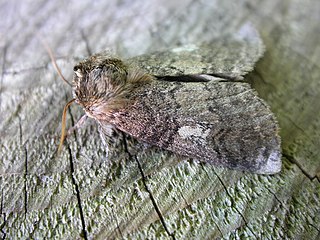
Tethea or, the poplar lutestring, is a moth of the family Drepanidae. It was first described by Michael Denis and Ignaz Schiffermüller in 1775. The species can be found in Europe, northern and eastern Asia and Japan. The imago resembles Tethea ocularis.

Agrochola macilenta, the yellow-line Quaker, is a moth of the family Noctuidae. The species was first described by Jacob Hübner in 1809. It is found in Europe and in Asia Minor.

Catocala electa, the rosy underwing, is a moth of the family Erebidae. The species was first described by Karl Friedrich Vieweg in 1790. It can be found in Europe and Asia.
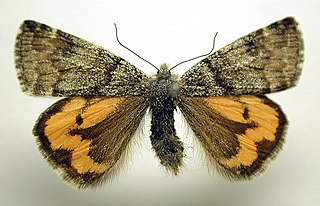
Archiearis notha, the light orange underwing, is a moth of the family Geometridae. The species was first described by Jacob Hübner in 1803 and can be found in Europe.

Minois dryas, the dryad, is a butterfly of the family Nymphalidae.

Pygaera is a monotypic moth genus of the family Notodontidae erected by Ferdinand Ochsenheimer in 1810. Its only species, Pygaera timon, was first described by Jacob Hübner in 1803. It is found in northern and central Europe, through eastern Asia up to Ussuri and Japan.

Gluphisia crenata, the dusky marbled brown, is a moth of the family Notodontidae. The species was first described by Eugenius Johann Christoph Esper in 1785. It is found in Europe, east over parts of Russia and China up to Japan. It is also found in North America, where it was traditionally treated as a separate species, Gluphisia septentrionis.

Stegania is a genus of moths in the family Geometridae. It was erected by Achille Guenée in 1845.
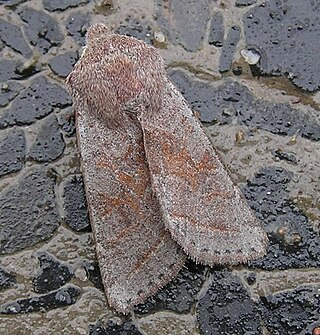
Orthosia opima, the northern drab, is a moth of the family Noctuidae. The species was first described by Jacob Hübner in 1809. It is found from central and northern Europe east to central Asia. In the west and north it is found from France through Great Britain up to southern Fennoscandia, south from the Alps up to the Balkans.
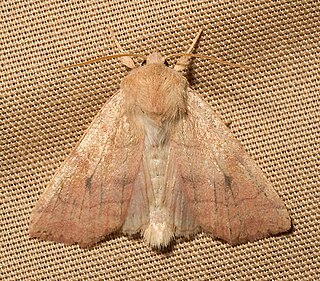
Enargia infumata, the lesser eyed sallow, is a moth of the family Noctuidae. It is found from Alaska and New Brunswick to Ontario, south to Connecticut in eastern North America. In western North America it is found from Saskatchewan and Alberta, south to Utah and California.

Nola aerugula, the scarce black arches, is a moth of the family Nolidae found in Asia and Europe. The species was first described by the German entomologist, Jacob Hübner in 1793.

Notodonta torva, the large dark prominent, is a moth of the family Notodontidae. The species was first described by Jacob Hübner in 1803. It is found in most of Europe, east to the China, Korea and Japan.

Choreutis diana, Diana's choreutis moth, is a moth of the family Choreutidae. It is found in northern North America and most of Europe. It was first described by the German entomologist, Jacob Hübner in 1819.
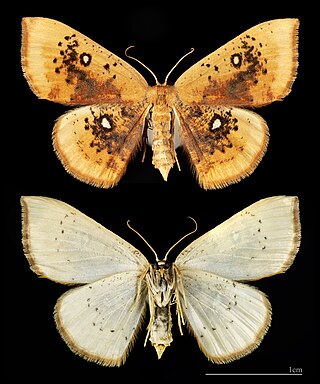
Cyclophora albiocellaria is a moth of the family Geometridae. It is found in south-eastern Europe and parts of Central-Asia.
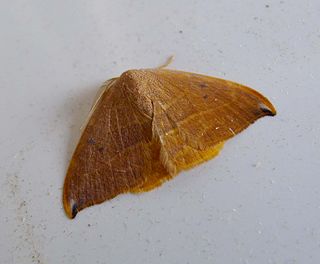
Drepana uncinula, the spiny hook-tip, is a moth in the family Drepanidae.
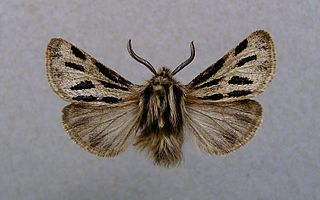
Ocnogyna parasita is a moth of the family Erebidae. It was described by Jacob Hübner in 1790. It is found in the Alps, the Black Sea region, the Balkan Peninsula, Asia Minor and southern Russia.






















